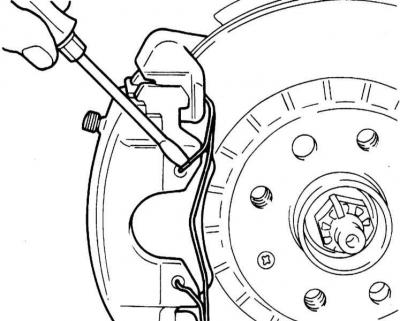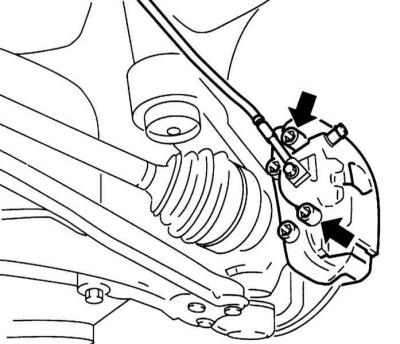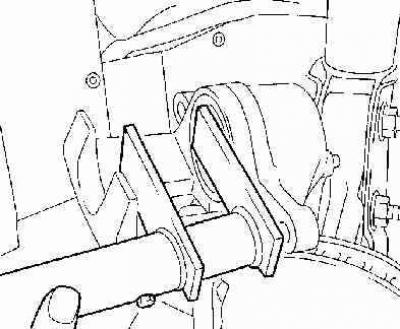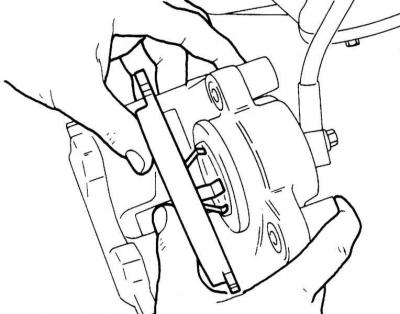Removing
To prevent the vehicle from pulling to the side during braking, the brake pads must be replaced on both front/rear brakes at the same time. Remember that the dust generated during the operation of the brake mechanisms may contain asbestos, which is extremely harmful to human health. Never blow off dust with compressed air or inhale it - wear a protective mask or respirator when servicing mechanisms. Never use gasoline or petroleum-based solvents to clean brake system components - use only branded cleaners or methyl alcohol!
1. Apply the parking brake, jack up the front of the vehicle and place it on jack stands. Remove the front wheels.
2. Disconnect the locking brackets from the brake caliper with a screwdriver.
Removing the fixing spring from the front brake caliper

3. Press out the two guide pin covers with a screwdriver.
4. Turn out directing fingers from a bracket.
Position of guide pins

Leave the brake hose attached so that you do not have to bleed the brake system later.
5. Remove the caliper assembly with the inner brake pads and hang it on a wire from the suspension strut. In this case, the brake hose must not be twisted or stretched.
6. Remove the outer brake shoe from the guide.
7. Press the inner brake shoe away from the piston. The block is fixed in the piston by means of a locking bracket.
If the removed brake pads are to be used again, they should be marked when removed. Rearranging the pads in places is not allowed, because. this can lead to uneven braking. Use original brake pads or pads approved by Opel. All front disc brake pads are replaced as a set, although only one of them may be worn.
Installation
Do not press the brake pedal with the brake pads removed, otherwise the piston may come out of the housing.
1. Clean with a soft brush or wipe with a rag soaked in alcohol the guide surface and pad seat.
Do not use solvents containing mineral oils or sharp-edged tools for this purpose
2. Before installing the pads, check the brake disc for grooves. If there are deep grooves, give the disc to the groove if it is still thick enough.
3. Measure the brake disc thickness (see Section Check of a condition, removal and installation of a brake disk).
4. Check the boot for cracks. Replace damaged boot.
5. Depress the piston using a suitable tool. This can be done using a block of wood or a hammer handle. When doing this, make sure that the piston does not warp, and the piston surface and boot are not damaged.
Pressing the piston with a special tool

When the piston is pressed, the brake fluid is squeezed out of the brake cylinder into the reservoir. Make sure the liquid does not spill out of the reservoir and pump it out if necessary. Remember that brake fluid is poisonous. Leaking brake fluid can damage paintwork and lead to corrosion.
6. If the brake pads are heavily worn, check the piston for ease of movement. To do this, insert a wooden block into the caliper and ask an assistant to press the brake pedal. The piston should slide in and out easily. Make sure the piston is not completely pushed out. If the piston does not move smoothly, have the caliper repaired.
7. Install the inner brake shoe into the piston.
Installing the inner brake pad

8. Insert the outer brake shoe into the guide.
9. Insert the caliper assembly through the brake disc from above into the guide groove.
10. Tilt the caliper assembly down and press it down.
11. Lubricate the guide pins with a locking compound such as Loctite Typ 262 and tighten them firmly 30 Nm.
12. Install the guide pin covers.
13. Insert locking brackets into the brake caliper.
14. Establish forward wheels so that the labels applied at removal have coincided. Lower the vehicle to the ground and tighten the wheel bolts to 110 Nm.
15. Press the brake pedal hard several times until resistance is felt. In this case, the brake pads are adjacent to the brake disc and take their place.
16. Check the brake fluid level in the reservoir and, if necessary, add fluid to the MAX mark.
17. Brake the car several times from 80 km/h to 40 km/h by gently depressing the brake pedal.
Avoid heavy braking for the first 200 km.

Visitor comments